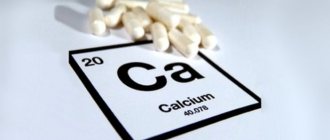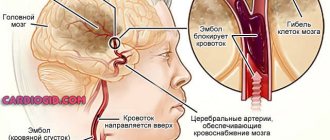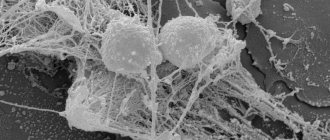Cholesterol is an organic substance that is part of cell membranes and is necessary for the functioning of all cells in the body. Cholesterol is a natural alcohol that is insoluble in water, but soluble in fats and organic solvents. Most of the cholesterol necessary for the functioning of the body is synthesized in the liver from fats, glucose and amino acids, and it also enters the body with food. Up to 2.5 g of cholesterol is synthesized in the body per day, about 0.5 g comes from food.
Cholesterol is an extremely important substance for the functioning of the entire body: it ensures the stability of cell membranes, is involved in the production of vitamin D, and is necessary for the production of various hormones by the adrenal glands. In the body, cholesterol is carried by lipoproteins, which have two fractions: low density (LDL) and high density (HDL). Low-density lipoproteins (called “bad cholesterol”) contribute to the deposition of cholesterol on the walls of blood vessels and the formation of atherosclerotic plaques. These plaques narrow the lumen of the vessel and interfere with normal blood flow, complicating or completely cutting off the nutrition of tissues and organs. High-density lipoproteins (“good cholesterol”) do not “clog” blood vessels, but, on the contrary, capture and remove cholesterol deposits that accumulate on the walls of blood vessels.
Elevated levels of cholesterol in the blood are dangerous - it is one of the main causes of the development of atherosclerosis, which, in turn, leads to the development of cardiovascular diseases, heart attacks and strokes, brain disorders and other diseases.
The level of cholesterol in the blood depends on many factors - genetic predisposition, gender, presence of chronic diseases, diet, age, lifestyle and physical activity.
What you need to know about cholesterol?
The content of the article
Cholesterol is a lipoprotein. Lipoprotein is a combination of fats and proteins. Most of the cholesterol (80%) is produced in the liver, 20% of it enters the body with food. A person needs no more than 300 mg of cholesterol per day.
Cholesterol performs several important functions:
- responsible for the formation of cell membranes, maintaining their strength and elasticity;
- participates in the production of bile by the liver;
- participates in the synthesis of vitamin D;
- participates in the synthesis of sex hormones;
- protects the nervous system;
- participates in metabolic processes.
Basic principles of a diet for high cholesterol
According to doctors, diet is an effective way to reduce the level of “bad” cholesterol in the blood. The main task of such a diet is to provide complete, balanced nutrition while limiting the intake of cholesterol into the body. This diet is called an antiatherogenic or antiatherosclerotic diet. Here are its basic principles:
- The amount of fat in the diet should be less than 30% of total calories, and saturated fat - less than 10%. To do this, you need to choose lean varieties of meat - lean poultry, rabbit meat, veal. Before cooking, trim off any fat from the meat. Increase the proportion of fish in your diet.
- Reducing your overall caloric intake to prevent excess weight gain. If a diet is prescribed in the presence of excess weight, then the calorie content is calculated in such a way that gradual weight loss occurs, and when the norm is reached, it is maintained.
- Frequent meals in small portions without overeating, 5-6 meals a day.
- Exclusion of foods rich in saturated fats - fatty meats, lard, egg yolk, cheese, full-fat dairy products, butter, processed meat products (sausages, sausages), caviar, coconut and palm oil. They are the main source of “bad” cholesterol.
- Avoiding trans fats, the consumption of which increases the risk of cardiovascular disease. Trans fats are found in margarine, baked goods, confectionery products, and many prepared foods containing vegetable oils (information about trans fat content must be indicated on the packaging).
- Reducing the consumption of simple carbohydrates - refined cereals, flour, refined sugar, sweets, fruit juices and carbonated drinks.
- Introducing foods containing Omega-3 polyunsaturated fatty acids into the diet. They are found in fatty fish - salmon, tuna, sardine, herring, mackerel, mackerel, and in smaller quantities in flaxseed oil, soybeans, avocados, spinach, broccoli, and nuts. You can take Omega-3 vitamin in capsules.
- The basis of the diet is foods high in complex carbohydrates and fiber: whole grain bread, cereals, vegetables, fruits, herbs, legumes. Of the legumes, soybean is the most useful - its biological active substances help reduce cholesterol levels. Soy is also an excellent source of complete protein, which can replace one of the meat meals.
What is cholesterol?
Low-density cholesterol (LDL)
– this is “bad” cholesterol. It settles on the walls of blood vessels and forms plaques. They grow over time and narrow the arteries, complicating or completely blocking blood supply to the heart and brain. As a result, the supply of oxygen and nutrients to these organs is disrupted.
High LDL levels are a leading cause of cardiovascular disease, heart attack, heart attack and stroke. LDL also has positive benefits, for example, it neutralizes harmful toxins.
Sources of “bad” cholesterol are animal products: pork, beef, bacon, chicken leg and fried skin, sausage, egg yolks, sour cream, cream, hard cheeses, cottage cheese, chocolate.
High density cholesterol (HDL)
- This is “good” cholesterol. It plays a structural role in cells, takes part in the synthesis of hormones and vitamin D. The liver produces bile acids, which help process fat in the small intestine, from “good” cholesterol.
“Good” cholesterol binds “bad” cholesterol and heavy triglycerides, removes them from cells, and transports them to the liver for processing. It helps prevent cardiovascular diseases.
Sources of “good” cholesterol: wild salmon, mackerel, tuna, halibut, avocado, olive oil, walnuts.
Triglycerides
are part of very low-density lipoproteins (VLDL), which are involved in the formation of cholesterol plaques. Increased levels of these fats in the blood can lead to heart disease and diabetes. After eating, the body converts excess calories into triglycerides. They accumulate in fat cells.
Problems arise if cholesterol levels exceed 5.0 mmol/L.
It is important to know the blood levels of all types of cholesterol. This:
- total cholesterol;
- low-density cholesterol (LDL) or “bad cholesterol”;
- high-density cholesterol (HDL) or “good” cholesterol;
- triglycerides.
Cholesterol norm
The normal levels of cholesterol in the blood are determined separately for women and men, and also depend on the person’s age. The established standards were adopted on the basis of scientific analysis of the results of laboratory tests of a large number of patients. The cholesterol level can fluctuate in the range of 3.6-7.8 mmol/l. However, doctors say that any cholesterol level above 6 mmol/l is considered elevated. Many patients taking a cholesterol test already have chronic diseases, especially for older people, so only a specialist can determine the individual norm.
A blood test determines:
- High density lipoproteins.
- Low density lipoproteins.
- Total cholesterol level.
- Triglycerides.
Causes of High Cholesterol
Causes of high cholesterol can be:
- overweight;
- eating large amounts of sweet and fatty foods;
- smoking;
- alcohol consumption;
- sedentary lifestyle;
- pregnancy.
High cholesterol is characteristic of certain diseases:
- congenital hyperlipidemia;
- pathologies of the hepatobiliary system;
- pancreas cancer;
- diabetes;
- hypothyroidism;
- kidney pathologies.
Upper and lower limits of normal for women. Table with main indicators
The data indicated in the table is for informational purposes only. To carry out tests, contact your local physician or a certified laboratory. IMPORTANT: only a doctor can correctly interpret the results, taking into account the patient’s medical history, her complaints (or lack thereof) and other diagnostic data.
| Age | Total cholesterol (TC), mmol/l | High-density lipoprotein cholesterol (good, HDL), mmol/l | Low-density lipoprotein cholesterol (bad, LDL), mmol/l | Triglycerides (TG), mmol/l |
| 15–20 years | 3,08–5,18 | 0,91–1,91 | 1,53–3,55 | 0,44–1,4 |
| 20–25 years | 3,16–5,59 | 0,85–2,04 | 1,48–4,12 | 0,41–1,48 |
| 25–30 years | 3,32–5,75 | 0,96–2,15 | 1,84–4,25 | 0,42–1,63 |
| 30–35 years | 3,37–5,96 | 0,93–1,99 | 1,81–4,04 | 0,44–1,70 |
| 35–40 years | 3,63–6,27 | 0,88–2,12 | 1,94–4,45 | 0,45–1,99 |
| 40–45 years | 3,81–6,53 | 0,88–2,28 | 1,92–4,51 | 0,51–2,16 |
| 45–50 years | 3,94–6,86 | 0,88–2,25 | 2,05–4,82 | 0,52–2,42 |
| 50–55 years | 4,20–7,38 | 0,96–2,38 | 2,28–5,21 | 0,59–2,63 |
| 55–60 years | 4,45–7,77 | 0,96–2,35 | 2,31–5,44 | 0,62–2,96 |
| 60–65 years | 4,45–7,69 | 0,98–2,38 | 2,59–5,80 | 0,63–2,70 |
| 65–70 years | 4,43–7,85 | 0,91–2,48 | 2,38–5,72 | 0,68–2,71 |
| > 70 years | 4,48–7,25 | 0,85–2,38 | 2,49–5,34 | 0,68–2,71 |
Causes of very low cholesterol
Causes of very low cholesterol may include:
- acute infections;
- sepsis;
- extensive burns;
- fasting and a very strict diet;
- eating too many fatty acids (omegas).
Very low cholesterol can be a sign of diseases:
- hypolipoproteinemia;
- hyperthyroidism;
- liver cancer and other oncological diseases;
- liver cirrhosis, especially in the later stages;
- chronic anemia;
- bone marrow pathologies;
- chronic pulmonary pathology.
How can you maintain normal cholesterol?
- To refuse from bad habits.
Alcohol and smoking negatively affect health, including good cholesterol levels. Give up these two bad habits - and your body will probably thank you with improved well-being and mood. - Eat properly.
Yes, it’s hard, because you really want fatty, fried, sweet... But hard doesn’t mean impossible! Start the process gradually. For example, first remove sweets, then a week later – fried foods, and after another week – fatty foods. Keep a diary recording your weight, cholesterol levels and other achievements. This way you will see the dynamics, which is usually the motivation for further action. If necessary, consult a nutritionist. A specialist will help you create a healthy diet. The Herbalife Nutrition company has developed a line of products that, in combination with proper nutrition, moderate sports activities and in the absence of contraindications, can help the body saturate cells with useful substances and get rid of toxins and waste.- "Thermo Complete". Can normalize metabolic processes, saturate and tone tissues.
- "Roseguard." Helps prolong youth at the cellular level and cleanse cells of antioxidants.
- Nightworks. Can be used to normalize the functioning of the cardiovascular system and saturate the blood with nitrogen.
- "Cell Activator". Helps quickly transform fat cells into energy.
- Exercise.
It is not necessary to do kilometer runs in the park, although some will like it. Take a walk, walk, join a pool or gym. If the park is far away, run at the stadium in the next yard. Is it hard to run? Another option is Nordic walking. Think about what would be interesting and enjoyable for you. Need some company? Invite your husband, girlfriend, child or other loved one with you. Treat sports not as a compulsion, but as part of your lifestyle.
Women need cholesterol. Undoubtedly. However, keep an eye on its level. Carry out control at least once a year and regardless of age. But remember that it usually depends on age what the upper and lower limits of normal cholesterol for a woman will be.
Delete and forget?
Patients consider such fat-like yellowish spots to be a cosmetic defect. To remove them, patients turn to cosmetologists, who solve the problem in a matter of minutes using liquid nitrogen, laser or electrocoagulation.
However, this does not solve the problem of high cholesterol.
According to the General Director of the National Medical Research Center of Cardiology, chief freelance cardiologist of the Russian Ministry of Health, Academician of the Russian Academy of Sciences Sergei Boytsov , common lipid stains on the walls of blood vessels are formed at a young age. By the age of 45, small plaques (with a narrowing of up to 40% of the lumen of the vessel) are already present in 50% of men, and by the age of 55 - in 50% of women. By adulthood, almost everyone already has them.
The examination, which helps resolve all issues, includes a biochemical blood test to determine cholesterol levels and a detailed lipid profile.
Shrimp are prohibited. Unexpected foods that increase cholesterol Read more
How to reduce blood cholesterol in women?
The most effective, but not the safest way is to take statins. In high concentrations, the latest generation of drugs can reduce cholesterol levels in women by 50–55%. However, statins have a lot of side effects: from very rare, but extremely dangerous, for example, rhabdomyolysis (destruction of muscle tissue), to simple, but quite common, such as malaise and weakness.
See also:
Cholesterol plaques in blood vessels, their treatment
Aspirin for atherosclerosis
Cholesterol prevention with folk remedies
With relatively low levels of excess LDL cholesterol (5.5 – 6.5 mmol/l), doctors try to prescribe more conservative treatment methods than taking medications: increasing physical activity (reduces LDL levels and increases HDL concentrations, quitting smoking and alcohol abuse (although 1 serving of alcohol - preferably red wine - on the contrary, increases the level of HDL, more details: alcohol and vascular atherosclerosis), changing the diet.
Factors contributing to the development of “fatty plaques”
One of the main modifiable factors affecting the condition of blood vessels and not related to diet is smoking. Smoking causes more damage to the cardiovascular system rather than the lungs. In addition, it is important:
- watch your weight;
- do not consume large amounts of salt, fatty animal foods;
- monitor triglyceride levels and the concentration of bad cholesterol in the blood.
A significant part of liver and kidney diseases nowadays can be treated, so it is necessary to regularly examine them and begin treatment as early as possible.
As for the causes of atherosclerosis related to genetics, age and early menopause, we can only hope for the best. Statistically, men are more at risk of atherosclerosis, although a number of researchers are inclined to think that this is due to a traditionally “male”, unhealthy lifestyle.
The factors “add up”, that is, the more factors, the greater the risk of “plaques”. By getting rid of even one “non-essential” risk factor, a person reduces the likelihood of disease.
Why do you need to lower cholesterol?
Reducing cholesterol levels is necessary to prevent diseases that can be caused by its excess. Such diseases include:
- atherosclerosis, in which the lumens of the arteries narrow or become blocked;
- coronary heart disease;
- myocardial infarction - death of the heart muscle, provoked by the fact that a coronary artery thrombus blocked the access of blood and oxygen;
- angina - insufficient blood supply to the heart muscle with discomfort or pain in the chest;
- strokes caused by the death of brain cells due to blockage of blood vessels by a blood clot and interruption of oxygen supply.
Risk factors: why cholesterol levels are rising
Factors leading to high cholesterol in men and women are divided into modifiable and non-modifiable. That is, those that can be changed - bad habits, eating habits, weight, blood pressure, blood sugar. And those that cannot be changed - genetics, age, gender.
The easiest and most logical way is to try to adjust your cholesterol levels by adjusting your eating habits, namely, giving up:
- products containing pure cholesterol;
- products containing trans fats;
- foods containing high amounts of saturated fat.
Overweight people need to lose weight. It can also solve problems related to blood sugar, blood pressure. That is, factors that not only affect cholesterol levels, but are also dangerous in themselves.
Elevated levels of cholesterol in the blood by such difficult-to-correct diseases as:
- diabetes, some liver and kidney diseases;
- polycystic ovary syndrome;
- thyroid dysfunction, hormonal dysfunction (in women).
At the moment, the level of “good” and “bad” cholesterol is also reduced with medications - corticosteroids, progestins, steroids. But this method has a number of side effects and disadvantages, and doctors try not to prescribe medications right away, especially when it comes to relatively young people.
where does cholesterol come from
Hypercholesterolemia - symptoms and treatment
The main goal in treating hypercholesterolemia is to prevent serious complications or at least reduce their risk.[8] This is achieved through the intermediate goal of correcting cholesterol levels in the blood, as well as by influencing other known risk factors for atherosclerosis.
When the cholesterol level in the blood is normalized and its concentration is maintained in the optimal range for a long time, the risk of myocardial infarction, stroke, and death from cardiovascular causes gradually decreases. Therefore, it is so important to maintain an optimal concentration of cholesterol in the blood (primarily “bad”) for as long as possible, ideally for life.
Of course, in many cases, changing lifestyle alone is not enough for this, especially since few people manage to maintain a healthy lifestyle for a long time - there are too many temptations along the way.
If there is a high risk of cardiovascular complications, medications that reduce the level of “bad” cholesterol must be prescribed, regardless of the patient’s intention to improve their lifestyle.
Currently, cardiology has abandoned the concept of “normal cholesterol levels”. Instead, the term “optimal cholesterol level” is used, and what it will be depends on the total cardiovascular risk. Based on the data obtained about the patient, the doctor calculates this risk:
- If the risk is very high (and this is, for example, all patients who already have coronary heart disease or have suffered an ischemic stroke, suffer from diabetes mellitus and a number of other categories), then the optimal level for “bad” cholesterol will be less than 1.8 mmol /l.
- At high risk (if the patient does not yet have atherosclerotic cardiovascular diseases, but he has several risk factors, for example, a smoking hypertensive man of 50 years with a cholesterol level of 6 mmol/l will have a high cardiovascular risk) the optimal value for " bad cholesterol will be less than 2.6 mmol/l.
- For everyone else who is not at high or very high cardiovascular risk, the optimal low-density lipoprotein cholesterol ("bad" cholesterol) value is less than 3.0 mmol/L.
If there is a genetic “damage” behind hypercholesterolemia, then lifestyle changes (diet, physical activity, smoking cessation) can only improve the biochemical composition of the blood to a limited extent, so additional drug therapy must almost always be resorted to.
What lifestyle changes can lower cholesterol and reduce the risk of heart disease?
First of all, this:
- reducing consumption of foods such as fatty meats, fatty dairy products, confectionery and sweets;
- complete cessation of smoking;
- reduction in body weight by at least 10% from the original, if there is overweight and obesity;
- increasing physical activity - fairly intense physical activity at least 4-5 times a week for 30-40 minutes, which requires effort (for example, running, cycling, outdoor sports games, swimming, etc.), including housework in this regard is not considered suitable physical activity.
All of these measures not only change the lipid composition of the blood for the better, but can also significantly reduce the risk of cardiovascular diseases associated with atherosclerosis (myocardial infarction, stroke, angina pectoris and others).
Drug therapy
The main drugs used to reduce cholesterol levels and its associated cardiovascular risks are statins. The first statins were obtained, like the first antibiotics, from mold cultures. The next generations of statins appeared thanks to chemical synthesis.
Statins are perhaps the most well-studied drugs in the history of medicine and also some of the safest.[9] This group of drugs inhibits the synthesis of cholesterol in the liver (yes, most of the cholesterol is formed inside us and does not come from outside). The liver, needing cholesterol primarily for the synthesis of bile acids, begins to more actively extract cholesterol from the blood as part of low-density lipoproteins, as a result of which gradually, over the course of a month or two, the concentration of cholesterol in the blood decreases and can decrease by 50% from the previous level with a sufficient dose of statin. The results of numerous clinical studies involving many thousands of patients provide convincing evidence of the ability of this group of drugs not only to reduce blood cholesterol levels, but also, more importantly, to seriously reduce the risk of myocardial infarction and stroke, and most importantly, to increase the life expectancy of patients with cardiovascular diseases (primarily those who have had myocardial infarction, as well as people with other forms of coronary heart disease).
Using intravascular ultrasound, the ability of statins, when taken regularly for at least two years, has been proven to stop the development of atherosclerosis and even reduce the size of atherosclerotic plaques.
It is important that, if there are indications for their use, treatment with statins is carried out in sufficient doses and for a long time - for a number of years. The usual doses in modern cardiology are 40-80 mg of atorvastatin and 20-40 mg of rosuvastatin. These are the two most effective modern drugs of this class.
The “gold standard” are the original drugs of the development companies - Crestor (rosuvastatin from AstraZeneca) and Liprimar (atorvastatin from Pfizer). The remaining statin drugs containing rosuvastatin or atorvastatin are generic copies and must demonstrate their equivalence to the original drugs in clinical trials. Many generic drugs do not have such confirmation of their effectiveness and safety, and their use can sometimes be disappointing. The advantage of generics is their lower cost.
Another drug that lowers the level of “bad” cholesterol in the blood is ezetimibe. It blocks the absorption of cholesterol in the intestinal lumen and is usually prescribed in addition to statins if they do not allow one to achieve optimal cholesterol levels in monotherapy. Ezetimibe itself allows you to reduce the level of “bad” cholesterol by 15-20% of the original level, i.e. inferior in this regard to statins.
A new class of drugs that has surpassed statins in their ability to lower bad cholesterol is the so-called cumabs, which are antibodies to a regulatory protein responsible for regulating the rate at which cholesterol is absorbed from the blood.[11] True, these drugs are very expensive (treatment costs 30-40 thousand rubles per month). But there are situations when this is literally necessary to save a life, when otherwise the patient may not survive the next five years due to myocardial infarction or stroke. In addition, this new class of drugs is used to treat patients with familial hypercholesterolemia in cases where the maximum dose of statin therapy in combination with ezetimibe is still very far from achieving optimal cholesterol levels.










